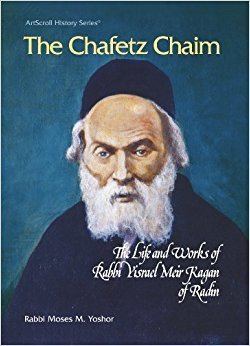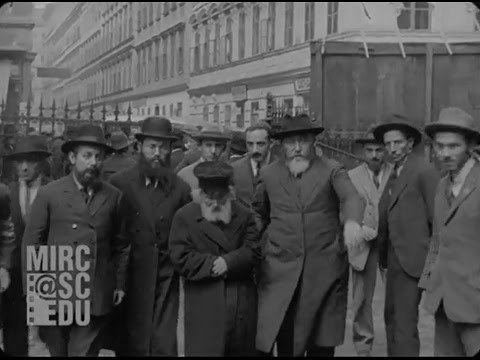Name Israel Kagan | Role Rabbi | |
 | ||
Born January 26, 1839 (11 Shevat 5599) ( 1839-01-26 ) Dzyatlava, Grodno Governorate, Russian Empire
(former lands of the Polish-Lithuanian Commonwealth) Died September 15, 1933, Radun', Belarus Books Chofetz Chaim: The Family Lesson a Day: The Laws of Speech with Stories and Parables for All Ages | ||
Rare footage of the chofetz chaim yisrael meir kagan at first knessia gedolah
Israel Meir (HaKohen) Kagan (January 26, 1839 – September 15, 1933), known popularly as the Chofetz Chaim (Hebrew: חפץ חיים, Hafetz Chaim), was an influential rabbi of the Musar movement, a Halakhist, posek, and ethicist whose works continue to be widely influential in Jewish life.
Contents
- Rare footage of the chofetz chaim yisrael meir kagan at first knessia gedolah
- Rare footage of the chofetz chaim yisrael meir kagan at first knessia gedolah 1923 with captions
- Biography
- Works
- References

Rare footage of the chofetz chaim yisrael meir kagan at first knessia gedolah 1923 with captions
Biography

Kagan was born in Dzyatlava, Grodno Governorate, Russian Empire (today Belarus), on January 26, 1839, and died in Radun', Wilno Province in Poland (now Belarus) on September 15, 1933. His surname, Poupko, is not widely known. His home town, Dzyatlava, was once named Zdzięcioł when it was part of the Polish-Lithuanian Commonwealth until the time of the partitions of Poland. When Kagan was ten years old, his father died. His mother moved the family to Vilnius in order to continue her son's education. While in Vilnius, Kagan became a student of Rabbi Jacob Barit. Kagan's mother later remarried (Epstein) and moved to Radin. At 17, he married the daughter of his stepfather, and settled in Radin.

He served as the town rabbi of Radin for a short period. He then resigned from this position to establish the yeshiva in the city, which eventually became world-famous. By all accounts he was a modest and humble man. For a while he had a shop selling household provisions, which his wife managed. However, the business was not successful and he turned to teaching in order to support himself and his family. From 1864 to 1869 he taught Talmud in Minsk and Washilishok.

In 1869, he formed a Yeshiva in Radin. The Yeshiva was a success and grew to prominence, later becoming known as "Yeshivas Chofetz Chaim of Radin". In addition to spreading Torah through his yeshiva, Kagan, who became known as the Chofetz Chaim, was very active in Jewish causes. He traveled extensively to encourage the keeping of the Mitzvot amongst Jews. He became one of the most influential rabbis within Orthodox Judaism during the late 19th and early 20th century, taking a central leadership role in the World Agudath Israel movement in Eastern Europe.
Although the anti-religious attitudes which pervaded Zionism greatly distressed him, Kagan initially refused to become personally involved in the matter and refrained from publicly denouncing the movement. When his views became known, he cautioned his students about joining the Zionists and declared its political aims as being contrary to the Torah. He nevertheless cherished the Holy Land and in 1925 it was announced that he would be leaving Warsaw with his daughter and son-in-law to permanently settle in Petach Tikvah, Palestine. Upon discovering his plans, prominent rabbis and yeshiva deans persuaded him to remain in Radun and he died there on September 15, 1933 aged 95.
Many other Jewish religious institutions throughout the world also bear his name. One American yeshiva named in his honor is the Yeshivas Rabbeinu Yisrael Meir HaKohen centered in Queens, New York founded by his great nephew, Rabbi Dovid Leibowitz, with several branches in the United States, Canada, and Israel. The Chofetz Chaim's teachings have inspired some English-speaking American Jews to establish the Chofetz Chaim Heritage Foundation, dedicated to the dissemination of his teachings to Jewish communities around the world. An Orthodox kibbutz in Israel, Hafetz Haim, was named in his honor.
The house of the Chofetz Chaim in Radin, was disassembled, moved to Lithuania, and later transported to the USA. This fact became the ground for a criminal case which is as of December 2012 in court in Belarus.
During his lifetime he was venerated by Jews and non-Jews alike. Orthodox Jews across the world viewed him as one of the 36 saints and Polish farmers were said to have lured him into their fields believing his feet would bring blessing to their crops.
